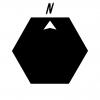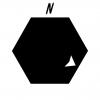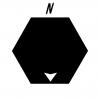Hi everyone.
In advance - thanks for all the great suggestions, you all help so much when I hit a roadblock and need advice.
So Thanks!!!
The concept: All the players are controlling the pawns on the board to escape the labyrinth from the minotaur.
I've settled on the idea that players have to roll from a pool of anywhere between 4-8 D6's so seen what actions are available in their turn.
I recently thought about the idea that the players can choose which direction the pawns move from hex to hex, and instead, it's an "If you roll Up, Down, Left, Right" those are the programmable movements you can distribute to your pawns in any order. Kinda like Magic Maze. E.G attached.
However, if a skull comes up on one of the faces on the D6, then that dice is removed from the game till a player sacrifices their turn (or rolls the opposite to a skull) to get that dice back.
This leaves me with the problem of having to convey which side a pawn can leave a hex, with 4 or 5 faces on the dice.
I wanted to ask what you think would be an interesting way of implementing that mechanic so its programmable movement, but also a push your luck system that effects other players turns.
p.s
Doesn't necessarily have to be dice. I'm open to other components.
Cheers
:)








This is a great suggestion!
I was wondering what you think might be a good plan to battle the whole "players taking ages to plan their turn" thing. The advantage of rolling dice would be a quick way of having your turn laid out for you (to some extent), without having to take time to plan it.